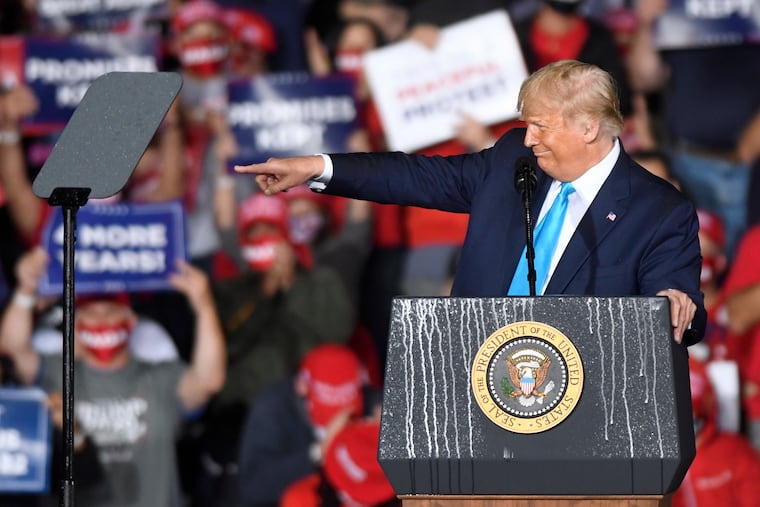Why it may be easier than ever for Trump to be elected by Pa. voters
Democrats once had an advantage of 1.5 million voters; today, it’s down by almost two-thirds. The reason? They're pursuing policies at odds with the values of many voters, writes Jennifer Stefano.

Dearest progressive reader, because I care about your well-being (if not your worldview), I urge you to pull up the fainting couch before you read the next sentence. If Donald Trump runs for president in 2024, he stands an even better chance of winning Pennsylvania than he did in 2016.
If your head is not spinning enough, you better lay down a bit longer, because it’s not only Trump who has a clearer path to victory today but all Republicans — whether they’re running for state or federal office.
In 2008, Democrats once held a voter registration advantage of almost 1.5 million voters; today, it’s down by almost two-thirds.
A key reason is because Democrats are pursuing policies that are at odds with the mainstream values of large numbers of voters.
Who knew that rampant crime, runaway inflation, and telling parents they have no say in their child’s education would be unpopular? Conservatives, apparently. They’ve been hammering the Republican Party for more than a decade to adopt policy initiatives, from criminal justice reform to school choice, that empower individuals over the state. The Pennsylvania Republicans used those ideas to add traditional Democrats and independents to their voter rolls.
» READ MORE: Why aren’t Biden and the Democrats doing more to stop crime in big cities like Philly? | Opinion
The Democratic Party’s decline in Pennsylvania began after the 2008 presidential election. That year, the Democrats’ registration advantage peaked at 1,236,467, or 51.2% of all voters. That October, then-candidate Barack Obama promised his followers that they were “five days away from fundamentally transforming the United States of America.”
Obama’s ascendence would dramatically alter the Democratic Party — because of both his left-leaning ideology and the ensuing conservative revolt within the Republican Party. Republicans responded with a policy platform that focused on limited government and individual freedom.
Obama’s policies won him two presidential elections and cost Democrats the future in swing states like Pennsylvania.
By the time President Obama won his second term in 2012, the Democrats’ advantage over Republicans in Pennsylvania had shrunk to 1,135,183. This trend continued through the Trump presidency at a faster clip.
Today’s advantage stands at just 553,827 registered voters, according to May numbers. So far this year, 62% of voters changing registration have been to the Republican Party, with only 22% switching to Democratic and 16% to independent or third party.
Voter registration changes represent a combination of newly registered voters, existing voters switching parties, and individuals removed from the rolls (due to death, moving out of state, or other reasons).
Last Tuesday’s primary elections showed how significant the enthusiasm gap is for Democrats. Republicans cast a total of 138,831 more ballots than Democrats in the race for governor, demonstrating a 9% Republican voter turnout advantage.
Who are the Pennsylvanians finding a new home in the Republican Party? Working-class Pennsylvanians whose jobs in the energy sector or trades have been derided or outright demonized by Democratic policies, starting with the Green New Deal. In 2021, the magazine City Journal recounted the swift transformation of two blue-collar New Jersey and Pennsylvania counties with robust energy industries from Democratic strongholds to Republican majorities. Westmoreland County, Pa., was dominated by Democrats two decades ago. Today it is safely Republican. As of 2021, every federal, state, and countywide official is Republican.
» READ MORE: Three Pa. bills to give parents more control over their kids’ education | Opinion
Philadelphia Democrats are fleeing, too. Reuters recently highlighted voter data that shows 1,315 Democrats in the city filed forms this year to change their party registration to Republican, more than four times the number of Republicans making the opposite switch. Even in 2020, a year when Joe Biden won the state, Philadelphia was the one Pennsylvania county that actually became more, not less, conservative.
Statewide elections reflect the same trends. Despite the Democrats’ registration advantage, Republicans won statewide races for president and the U.S. Senate in 2016, for two of three row offices in 2020, and three of four judicial races in 2021. In the last couple of election cycles, five of the seven statewide, nonpresidential races were won by Republicans by narrow margins.
Another obvious but often dismissed fact: candidates matter. In 2020, 20 Pennsylvania House districts split their vote: 12 Republicans won in districts carried by Biden, and eight Democrats won districts carried by Trump. Some years have seen greater splits — in 2014, when Gov. Tom Wolf was elected, 30 state House Republicans won in districts that Wolf carried.
Issues matter, too, and voters are increasingly finding Democrats on the wrong side of them.
National polling shows that voters shifted significantly toward preferring smaller government and continue to prefer capitalism and free enterprise to give individuals more power to solve their own problems, rather than putting it in the hands of bureaucrats via socialism and the federal government. There’s bipartisan support among voters for educational choice, governmental spending limits via the Taxpayer Protection Act, voter ID, Medicaid work requirements, and privatizing state liquor stores. All conservative ideas.
Alas, dearest progressive readers, how to stop this trend? The answer, as always, lies in the mirror. Good policy makes for good politics and fat voter rolls. Just ask a Pennsylvania conservative.
Jennifer Stefano is the executive vice president at the Commonwealth Foundation.